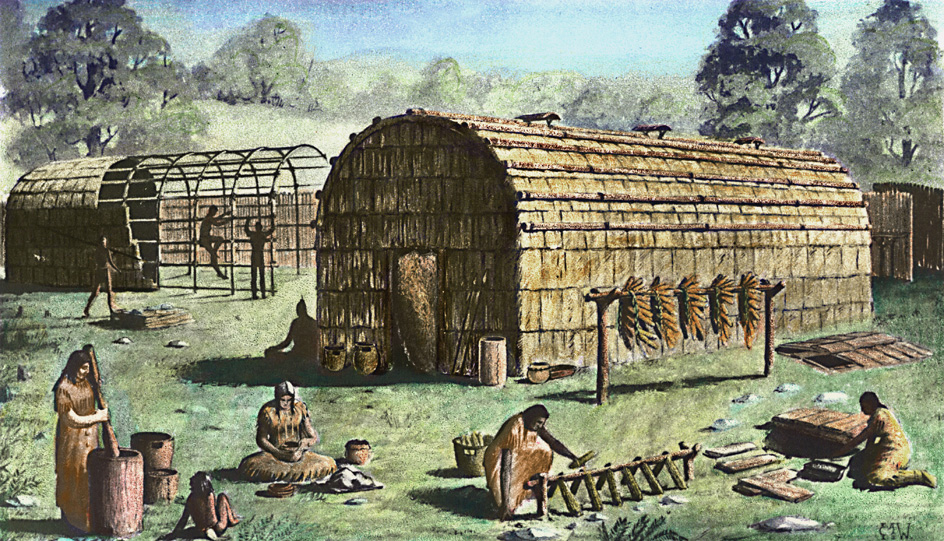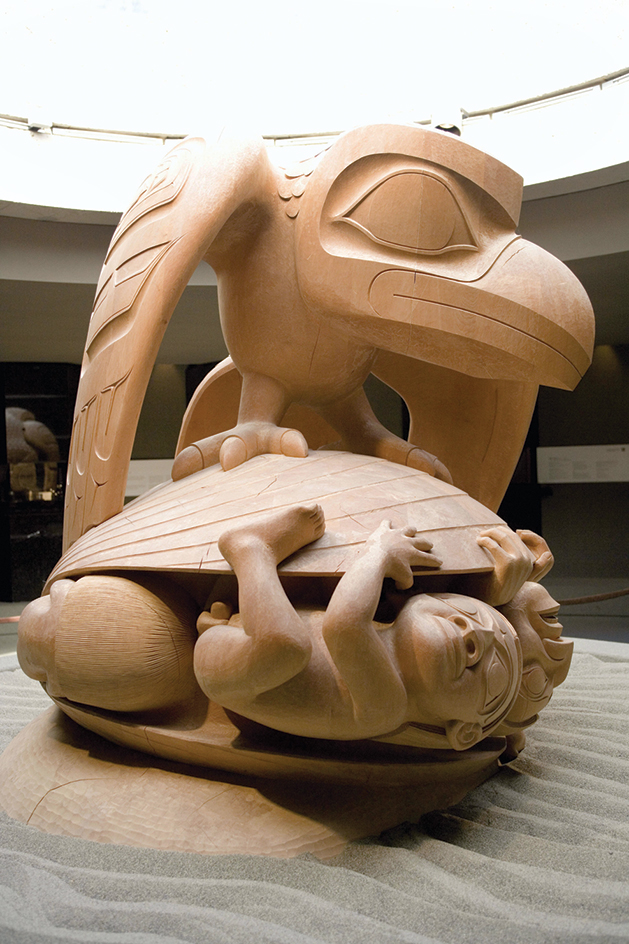First Nations are original peoples of the land that is now Canada. Their ancestors lived in the region for thousands of years before Europeans arrived there. According to tradition, First Nations have always lived in Canada. But most scientists think that human beings traveled to the Americas from Asia, about 15,000 years ago or earlier. Before the arrival of Europeans, First Nations were able to satisfy their material and spiritual needs through the resources of the natural world around them.

First Nations make up one of the main groups of Indigenous or Aboriginal (native) people in Canada, along with the Inuit and the Métis. Some Canadian legislation refers to First Nations people as Indians. However, many people consider this term to be outdated and offensive. Inuit are Indigenous people of the Arctic. Their ancestors arrived in North America after the First Nations’ ancestors. Métis are people who have both First Nations and white ancestry. Métis culture developed primarily in the Red River Colony in what is now Manitoba in the 1800’s. The word Métis comes from an old French word meaning mixed.
Today, there are more than 600 recognized First Nations governments in Canada. About half of all First Nations people live primarily in the provinces of Ontario and British Columbia. This article provides general information on First Nations in Canada. For more information, see the separate articles on individual groups.
First Nations groups

The Subarctic
is a large region that includes the interior of Alaska and much of northern Canada. It is a challenging environment of barren lands, dark forests, and swampy terrain called muskeg. It has cold winters and heavy snows, many lakes and streams, and forests of fir, pine, spruce, and other evergreen trees. It is one of the most thinly populated regions of North America.

The First Nations who lived in this rugged region belonged to one of two major language groups—Algonquian speakers in the east and Athabascan speakers in the west. Despite their language differences, the two groups had similar ways of life. Food was often scarce, and the people moved about hunting and gathering wild plants, berries, and nuts. The growing season was too short for farming. The people hunted buffalo, caribou, deer, elk, and moose. Fish and shellfish were important foods along the coasts, rivers, and lakes of the region.
Houses were made of wooden frames covered with bark, brush, or animal skins. People also built dome-shaped wigwams, lean-tos, tipis, and sturdy log houses. In summer, the people of the Subarctic used bark canoes to travel the lakes, rivers, and streams in search of food.
The Northeast


First Nations of the Northeast are often divided into Woodland and Iroquoian groups. Woodland groups lived farther north, and Iroquoian groups lived farther south. Almost all the First Nations in the Northeast region spoke an Iroquoian or Algonquian language. They lived mostly by growing corn, beans, and squash. Women farmed and gathered wild plants, nuts, and berries. Men hunted and fished. Some of the northernmost groups depended more on hunting, gathering, and fishing than on farming.
First Nations of the Northeast traveled on foot or in bark canoes. They made deerskin shirts, dresses, leggings, and breechcloths. In some groups, men shaved their heads almost completely, leaving only a small tuft of hair on top.
Religion played an important part in the lives of Northeastern First Nations. The people believed in a spiritual power that inhabited many creatures and forces of nature and could appear in visions as guardian spirits. In some Algonquian languages, this power was called manito. Religious leaders called shamans could summon helper spirits to cure diseases.
The Iroquois called themselves the Haudenosaunee. This name refers to their dwellings and means we longhouse builders. The Iroquois became famous as the Five Nations, or Iroquois Longhouse. This federation was the most complex political organization among North American Indigenous peoples.
The Plains


Most of the First Nations of the Plains lived in villages along the rivers and streams where the land was fertile and easily cultivated. Women tended crops of beans, corn, squash, and tobacco while the men hunted deer, elk, and sometimes buffalo. During the summer, the people left their villages to hunt the vast buffalo herds on the Plains. In the fall, they returned to the villages and harvested their crops.
Plains people wore deerskin breechcloths, leggings, and simple shirts. They used buffalo hides for winter robes. While in their villages, the families lived in earth lodges or frames of logs covered with hides.
The religion of Plains First Nations centered on spiritual power. Almost every man and some women had a personal guardian spirit. They often carried medicine bundles containing plants, stones, and other objects that they believed had supernatural powers.
The Plateau
covers most of the southern half of British Columbia east of the coastal mountains. In the United States, it also includes parts of Washington, Oregon, Idaho, and Montana, as well as a small section of northern California. Forests and grasslands cover most of the north. The south is semidesert.
The First Nations of the Plateau lived in bands consisting of extended families. Each band lived in its own territory but was related through marriage to other bands in the tribe. During the summer, bands traveled their territory in search of food. In the winter, they lived in villages. Each village had one or more respected leaders, most of whom were men. These leaders gave advice and helped settle disputes.
Foods eaten by Plateau First Nations were wild bulbs and roots, including camas and bitter root; such berries as blackberries and huckleberries; and salmon and other fish. Women gathered the berries and dug the roots and bulbs. Men did the fishing. They also hunted rabbits and other game. During the 1700’s, some Plateau First Nations people acquired horses, which the Spaniards had introduced to the New World. The Nez Perce in particular then began to hunt buffalo.
Plateau First Nations believed that shamans could heal people and had some control over the spirit world. Both boys and girls went on vision quests to seek out guardian spirits. During round dances, the dancers sometimes went into trances and had visions.
The Northwest Coast,

First Nations of the Northwest Coast built houses with large posts and beams, covered with planked sides and gabled roofs. Several families lived in one of these large structures. Great seagoing canoes, some more than 60 feet (18 meters) long, were burned and cut from the trunks of huge cedar and redwood trees. Many First Nations of the Northwest Coast carved the family and clan emblems on totem poles.
First Nations in this region often measured wealth in terms of such possessions as canoes and blankets. Men, and some women, of wealth and social position proved their right to high rank at a feast called a potlatch. During a potlatch, which lasted several days, a host fed the guests and gave away many valuable items. The gifts earned respect for the host and the host’s clan and indicated the social rank of the individuals who received them. Some potlatches were held to mark births, marriages, and deaths.
Northwest Coast First Nations believed in many gods. During the winter, secret societies dramatized various myths. These performances were mainly religious ceremonies.
European contact and beyond
The history of the Americas includes the story of relations between the Indigenous peoples of the Western Hemisphere and the European explorers, trappers, and settlers who arrived there beginning in the late 1400’s. Most of the Indigenous people were friendly at first and taught the newcomers many things. The Europeans brought many goods that were new to the Indigenous people. These goods included metal tools, guns, and liquor. The Europeans also brought cattle and horses, which were unknown to the local population.
The First Nations of the Eastern Woodlands were among the first Indigenous peoples to meet European explorers and settlers. The Europeans carried diseases, including smallpox and measles, that killed many Indigenous people. As the settlers arrived, they took the land for their own. When the Indigenous people objected, fighting broke out. Some of these battles grew into wars. The Northeastern First Nations also became involved in the wars between France and Britain for possession of North America. The First Nations took sides in these wars and often ended up fighting one another as well as the white settlers. Many Algonquian groups sided with the French. The mighty Iroquois League generally allied itself with the British and helped Britain gain control of almost all of France’s territory in North America.

As Europeans spread westward across North America, they became a greater and greater threat to Indigenous ways of life. In Canada, many First Nations were moved to areas called reserves. In the late 1800’s and the 1900’s, Canada’s government forced First Nations and other Indigenous children to attend residential (boarding) schools, where they were cut off from their cultures. These schools, and Canadian laws, sought to assimilate (incorporate) Indigenous people into mainstream Canadian society. However, First Nations have fought to protect their lands, rights, and cultures. Today in Canada, there is more emphasis on reconciliation—that is, establishing and maintaining a respectful relationship between Indigenous and non-Indigenous people.
